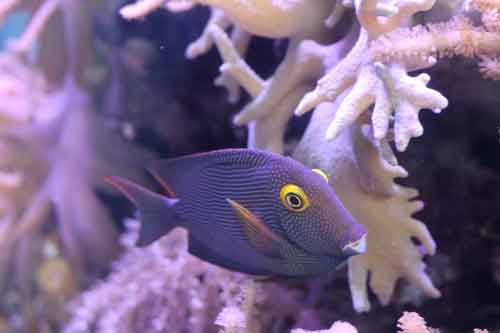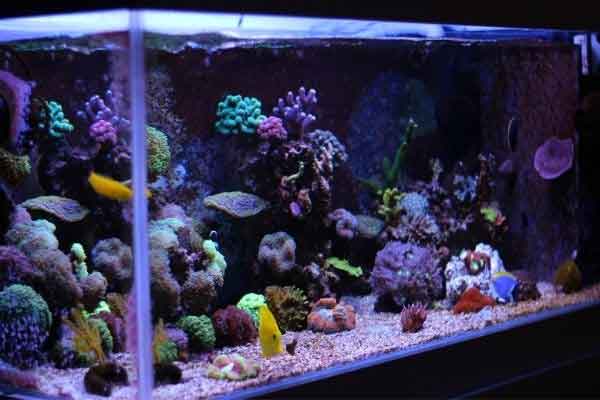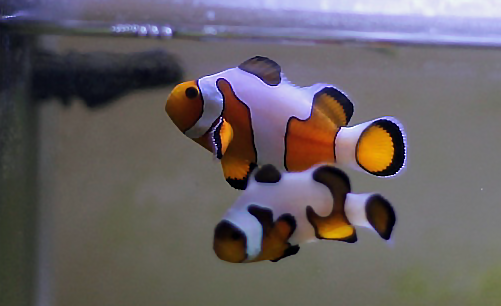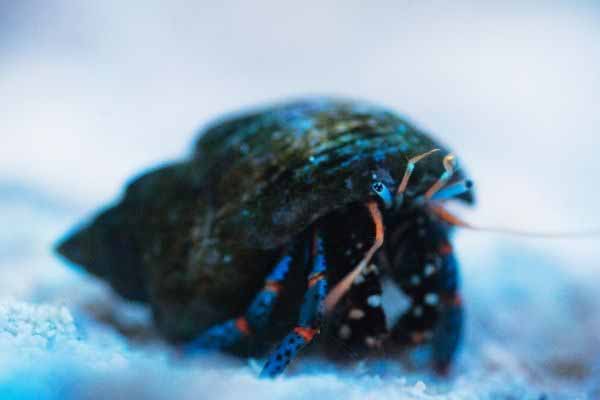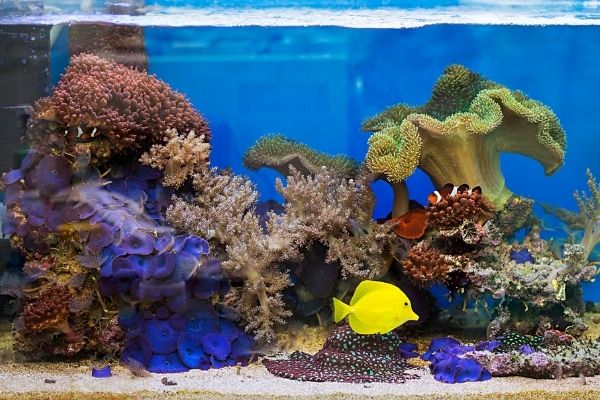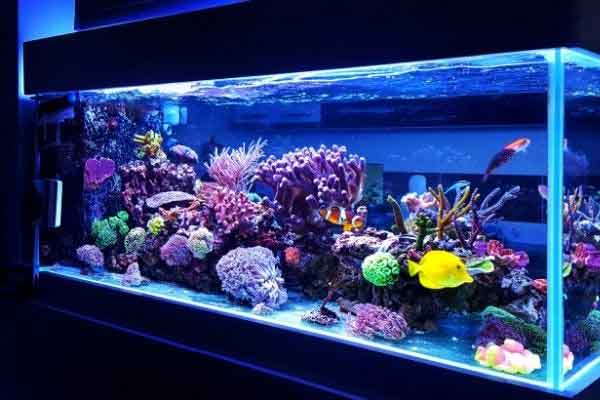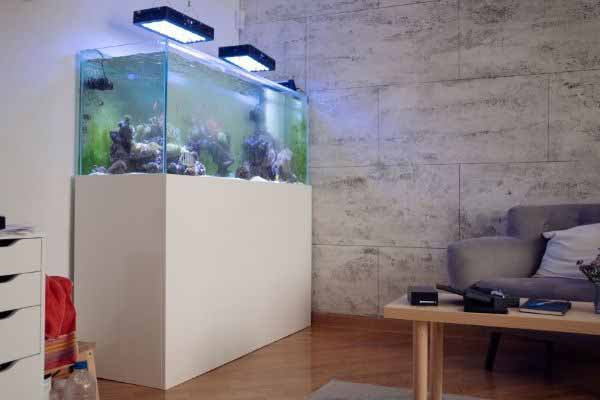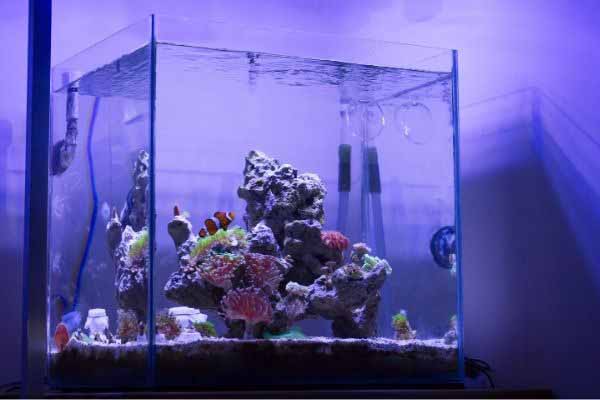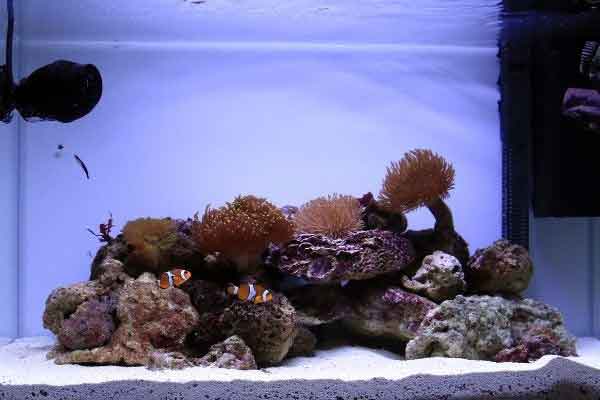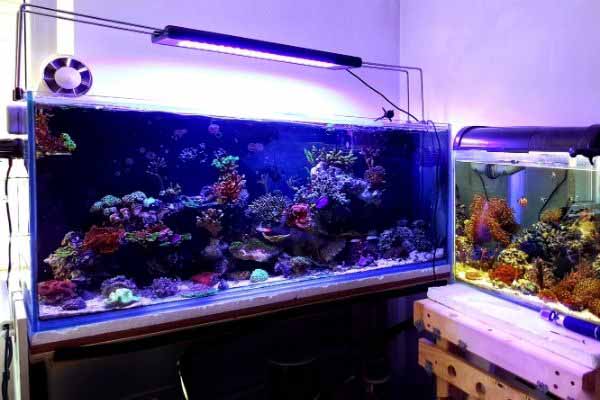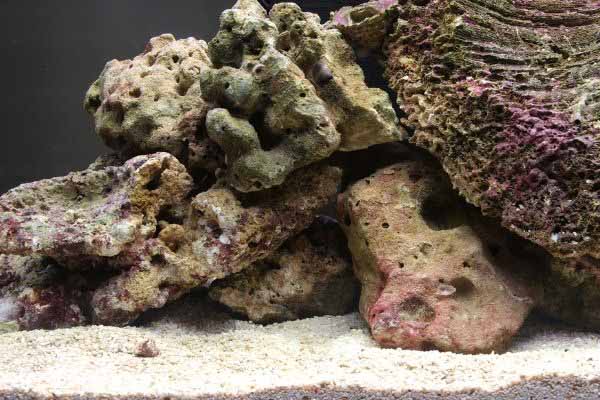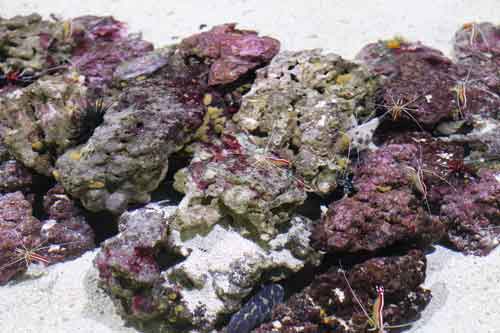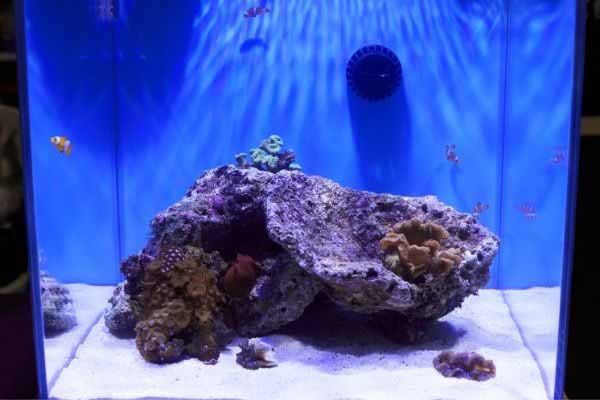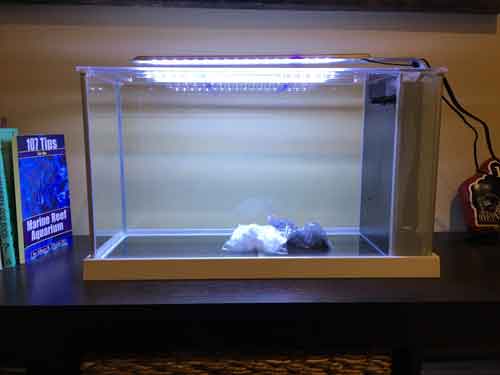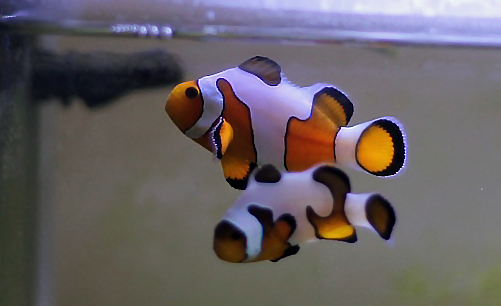[ad_1]
Do you want to know how to set up a saltwater aquarium? You can enjoy the beauty and relaxation of a saltwater tank in your own home without breaking the bank if you follow the steps in this how-to guide.
Table of contents
If you have a specific question, you can use the Table of Contents navigation below to jump right to it, or read the rest of the article, which is intentionally written in a helpful, progressive way.
A few questions designed to help you get started
Before we jump right into the how-to section, take a moment to reflect on what you want and what your starting point is. The answers to these questions can help shape your starting point.
What type of saltwater aquarium do you want to set up?
Take a moment to close your eyes and picture your dream saltwater aquarium in your home or office. What does it look like? Is it large or small? What is in it? Are you interested in keeping a reef tank, with fishes, corals, shrimp, crabs, snails, and clams zipping about an intricately designed rockwork (called an aquascape)?
Or are you thinking about a more open design with a few larger fish swimming about?
If you don’t know the answers to these questions yet, that’s totally fine–most people don’t know these answers when they first start out. But the answers to those questions could impact the ideal saltwater aquarium set up so it can be helpful to try and think that through before you actually start setting up your own saltwater tank.
Is there a certain look or style you’re going for?
When you envision the perfect saltwater aquarium in your home, what does it look like? Is there sand at the bottom of the tank, or do you see the glass bottom? Do you have a thin layer of sand or is there a deep sand bed? Is it fine sand, like at the beach, or with larger, more chunky coral skeleton sand?
This is largely an aesthetic decision on your part. A deep sand bed adds some water quality improvement capability to your tank and creates a mini-ecosystem for some marine life you otherwise wouldn’t have, but it is totally optional and is viewed as ‘ugly’ by many. A small sand bed serves almost no utility but creates a look that many people want.
A bare bottom tank has a clean look that makes it easy to keep clean and is also preferred for those tanks with the most demanding corals–because those corals often require lots of water movement which would stir up the sandy bottom if you had one.
So the choice is really yours, based on the look you want to achieve. Here is an article to help you pick the right aquarium sand/substrate. You can learn more about deep sand beds here.
How much knowledge and experience do you already have?
Another important factor to consider, before you get started, is to realistically and fairly assess how much knowledge and experience you already have with keeping fish, plants, and invertebrates alive in an aquarium. If you already have a lot of experience (perhaps from a pond or a freshwater aquarium), or if you have already done a bunch of research, you may be able to have success with a moderate-difficulty tank design.
If you are relatively low in knowledge and experience (now), don’t worry, you can still have great success. Let’s just work together to help you figure out how to set up a saltwater aquarium that suits your individual needs.
If you do have some significant experience in keeping a freshwater tank, check out this specific article about converting from freshwater to saltwater.
Difficulty level
Beginner level
If you are starting at the beginner level, the most practical place to start is with a fish-only tank (FO), a fish-only with live rock (FOWLR), or a FOWLR with a clean-up crew.
Generally speaking, the easiest fish to buy and care for in a saltwater aquarium are those that were born in captivity (called aquaculture). These fishes have lived their whole lives in reef tanks and are generally best suited to life in your home. That doesn’t mean that every fish, crab, or snail is easier than corals to care for–it just means that my opinion is that the easiest-to-care-for fishes are easier than almost any coral.
The snails and crabs most suitable for a new saltwater tank are fun to watch and are also practical because they help clean up the tank and are often part of something called a clean-up-crew.
- A great snail to start with is a cerith snail or the turbo snail. Other snails are hardy and easy to add, but perhaps not as useful as these two species, for the new saltwater aquarium set up.
Beware of keeping tiny blue-legged hermit crabs and cerith snails together. On the surface, they may seem compatible, but keep in mind that hermit crabs need other shells to grow into–and they might evict the snail from their home in order to upgrade.
Moderate level
If you are starting at a moderate level, or think you’ll level-up relatively quickly, you may want to consider testing your skills with a reef tank setup that includes beginner-to-moderate saltwater fishes and beginner soft corals. At this point, you may want to consider adding mushroom corals, leather corals, or even certain zoanthids.
You can also broaden your search beyond aquaculture-only and start to consider some of the more popular wild-caught fishes.
Advanced level
At the advanced level, caring for your saltwater aquarium often becomes more about growing the most demanding SPS and LPS coral species than it is about caring for the fish, because the most demanding corals have such strict light, water quality, and food requirements.
I would also put jar-reefing, picotype aquariums, and even some biotope aquariums in the advanced category because it takes some advanced knowledge and planning to ensure success.
Final thoughts on the difficulty level
The difficulty levels described here are a rough-cut. The only absolute in the saltwater aquarium hobby is that there are always exceptions to every rule. Not all aquacultured fish are appropriate for beginners. Not all soft or leather corals are easy to care for, and not all LPS and SPS are difficult. Nearly all things in the hobby can be conquered if you educate yourself, plan, and take your time.
All-in-one vs. Build your own
Another important decision to make, before you plan your saltwater aquarium setup and get started is to decide whether or not you want to purchase an all-in-one kit or build your own aquarium by purchasing your tank and equipment separately.
All-in-one
The first option (buying an all-in-one aquarium kit) is the easiest way to get started, building your own, of course, provides you with the greatest flexibility and lets you create exactly what you want and need. That’s really a personal choice based on your own personality and resources. Popular all-in-one aquarium brands are JBJ Nano Cubes and Coralife BioCubes.
You should be able to find them at your local fish store or online at Amazon.com or any specialty online aquarium store. If you would like to learn more about these options, you can find more information at the manufacturer sites: JBJ Nano Cube Coralife BioCube If you are ready to purchase, check out the prices on Amazon first.
If you decide to buy, as a result of clicking the Amazon link (it is called an affiliate link), I will get credit for the referral and can earn a small commission at no additional cost to you.
No pressure, just want to be clear that there is the potential for a financial benefit there. What is most important to me is that you do your research and buy from a place you know and trust. Support the companies that you believe in–if that’s your local fish store–buy there. If you choose to use this (or any other affiliate link on my site), THANK YOU! Ok, sorry for the digression there…let’s get back to it.
The disadvantages of the all-in-one styles are that they are generally smaller and less customizable. They are designed to be attractive-looking, self-contained units and customizing, adding sumps or other equipment or automation can be more challenging–which makes them great as a first-time saltwater aquarium, but not great as an all-time saltwater tank.
Build your own
If you are a bit more adventurous, you might want to consider building your own. This requires a bit more reading, planning, and manual labor. Those who enjoy this approach are generally (but not always) mechanically inclined and enjoy having the latest or coolest technologies. Enjoyment in the hobby comes from equal parts between the living things in the tank and the design/gear because it requires you to work on your tank, as well as admire it.
Choosing between acrylic vs. glass
What material do you want your saltwater aquarium setup made from? The two big choices are acrylic (a type of plastic) or glass (a type of…um…glass). Acrylic is more lightweight than glass. So if you know you are going to move in a year or two…maybe you want to buy an acrylic tank.
Acrylic is also a more versatile construction material, so you will often see acrylic as the material used in some of the more modern all-in-one designs.
One thing to watch out for is that acrylic scratches more easily than glass, but if it gets really scuffed up, you can actually buff out the scratches–which is a benefit to acrylic–whereas scratches in glass are more permanent. But if you think about it…in order to buff out the scratches in an acrylic tank, you have to empty the tank and do some hard work–so weigh the pros and cons of each material before you buy.
For the record–I would be comfortable recommending either. If you want to save some money or get a bigger tank than you could afford if you purchased a new tank, try to find a used and scratched up, acrylic tank and repair it. If you’re willing to put the time in, you can get it looking good as new. If interested to see how much work would be involved in repairing an acrylic tank, check out the video below.
You would need an acrylic repair kit like this one in order to complete this repair yourself:
If you don’t have a strong opinion either way (like me), then just note which designs you like more, and go with that.
Aquarium sump setup
Another important thing to consider is whether you will have an aquarium sump setup underneath our tank.
This is a specialized tank you keep under your display aquarium that adds additional volume to the tank, is partnered with a large return pump that oxygenates and provides water flow, and provides a place to add your protein skimmer, heater, and refugium. The basic premise and design are as follows:
- A small pipe, called an overflow, sends water down into one end of the sump.
- A filter sock then is generally used to catch debris at this point and provide mechanical filtration.
- The water then generally travels through a protein skimmer, where organic materials and other solids not caught in the sock get removed.
- The water is heated by the heater and then the water travels through a refugium, which is an area where macroalgae and invertebrates are deliberately cultivated to help purify the water by removing nitrates and phosphates, and then finally, the water flows through series of baffles, which traps any remaining detritus and microbubbles.
- Then a return pump sends the water back up into the display. The extra water returning into the tank causes the water level to rise above the overflow pipe (see how it gets its name?) and the cycle continues.
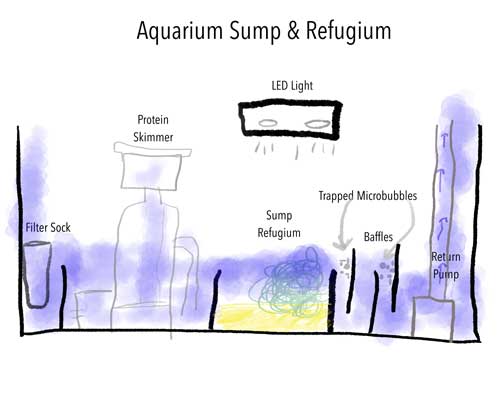
LED lights over the aquarium sump give the macroalgae a source of energy to conduct photosynthesis and remove impurities from the water
That’s sort of an upper-middle-of-the-road sump design. You could add UV sterilization, a calcium reactor, phosphate reactor, chiller, and an auto top off (to replace evaporation). Those are great options but are also more advanced than this introduction to how to set up a saltwater aquarium.
You could also just have an aquarium sump that acts as a big reservoir without differentiated sections–just have the water drain into one area, pumped out the other. That’s one of the many awesome aspects of this hobby, you can start off low tech and upgrade as your interests, budget and time allow.
Here are a few links to where you can find some more in-depth information:
Location: 6 considerations for identifying the perfect location for your saltwater aquarium
- The floor must be able to support the weight
- Nearby ‘stuff’ won’t be ruined if it gets wet or salty
- Accessible
- Visible
- Not prone to major hot or cold temperature changes
- Well ventilated
1. A vital aspect of deciding where to put the tank: The floor must be able to support the weight
Your new saltwater aquarium setup is going to be HEAVY. A 20-gallon aquarium (75 liters) will weigh over 200 pounds. A 92-gallon (378 liters) corner aquarium weighs more than 1050 lbs (476 kilograms).
That’s heavy.
It might be the heaviest thing in your house.
You certainly don’t want your saltwater aquarium falling through the floor, or off the shelf or breaking the stand. So it is very, very important to make sure you place the tank in a location that can handle the weight. If you aren’t sure how heavy the tank you want to buy is going to be, you can check out this awesome reference table here.
2. Nearby ‘stuff’ won’t be ruined if it gets wet or salty
The area (mostly the floor, but also the walls) surrounding your saltwater aquarium setup is going to get wet. Salt creep may end up on end tables, the walls, or floors. When you slog around buckets of water, for water changes, you’ll probably drop some water. If you have brand new hardwood floors made from rare Brazilian rain forest wood that warps the first time it gets wet…you probably don’t want to put your fish tank on that wood. I recommend you be careful and think it through to make sure you’re not disappointed later. But water has a habit of splashing and dripping.
3. Accessible
You need to be able to reach into your saltwater aquarium setup to clean the glass or arrange rock-work. If you have any plumbing running behind or below the tank, you also need to be able to get in there. So make sure you place your aquarium somewhere you can access it.
4. Visible
You want to enjoy your aquarium, don’t you? After all, that’s why you are getting into the hobby. Pick a place in your home where your tank will be visible and you will enjoy it. Just remember that it will be giving off light and will make some noise, so the best spot may or may not be in the room where you watch television or record your audio podcast. Other than the light/noise contribution to the room, focus on placing it where it looks awesome and you will enjoy it.
5. Free from big temperature changes
If you have a room in your house that always heats up…or is freezing in the winter…or where the sunlight blazes and bakes everything with radiation…you may not want to put your tank there. A common myth is that placing your tank next to a window will cause major algae outbreaks.
I don’t necessarily agree with that in most cases for a saltwater aquarium setup…but I do think you should determine if the window is going to be a major source of heat loss or heat gain for your tank.
If you have drafty windows or the sun heats up a room in your house (above the temperature you would want for your tank ~78 degrees F) you may want to set it up somewhere else. I have my tanks next to a window in my house and have no issues with heat or extra light, but your situation may be different depending on how warm or cold that room gets as a result of the direct sunlight.
6. Well ventilated
Water will evaporate out of your tank and into the air in the room, which will increase the humidity of the air in the room. So if you need dry air to sleep…you wouldn’t want to put the aquarium in your bedroom.
A few years back, I set up a rack of tanks in my basement. It was pretty awesome and pretty terrible, at the same time. It was awesome because I got to keep a bunch of different tanks and watch their pairing-up and spawning behavior.
It was terrible because it made my basement very, very humid/damp. There was so much humidity down there that stuff started to rust. Ugh. Even if it’s not so bad that the humidity builds up, you will find that smaller, less ventilated rooms are also more likely to smell like the fish tank, as well.
So the perfect location for your tank is a spot in a well-ventilated room.
Equipment and test kits
In addition to the saltwater aquarium itself, you are also going to need equipment to keep the saltwater aquarium setup running and keep the animals or plants in your tank happy and healthy. From an equipment perspective you need the following (at a minimum):
- Lighting
- Powerheads for water movement
- Temperature control (heater and/or chiller)
- Maintenance gear (gravel vacuum and bucket)
- Test kits
For more information, check out the equipment guide page.
There are about 12 water parameters that are key to keeping a happy, healthy reef tank. 9 of them are essential for every tank. 3 are for troubleshooting more sophisticated problems.
You can learn all about the 9 most important saltwater aquarium water parameters and which test kits are essential here.
How to set up a saltwater aquarium: Step-by-step instructions
Ok, now that you have picked out the perfect tank and equipment for what you want to care for, let’s get it set up, step-by-step.
Step 1: Test the tank for leaks
The first step in setting up a saltwater aquarium is to test the tank for leaks. Take a look at the video below. You really don’t want that to happen to you.
That is a bad time and a bad spot to find out that the aquarium has a leak. Before put your tank in the perfect location, you want to make sure it’s going to hold up its end of the bargain first–by filling it with water in a safe location. Here’s what you do:
- Set your tank up somewhere it will cause the least damage if it makes a big mess like this. If you have a driveway, backyard, or even a parking spot you can reach a hose to–try that. If not, think about what room in your house, apartment, flat, or condo where you can soak up a wet mess pretty easily–that might be a bathroom, kitchen, laundry room, garage, mudroom, or basement. The key here is that the spot needs to be level, able to support the weight and easily cleaned up if you spring a leak.
- Fill your tank with fresh water. Don’t worry about mixing salt at this stage, you’re literally just trying to make sure the tank won’t make a mess on your floor.
- Dry the outside of the tank with a towel–you want to get up all the drips and any water that is pooling around the edge molding. Do your best to make sure the only water you see is the water inside the tank because what you are looking for, after this step, is any water outside of the tank.
- Mark the water level on the outside of the tank with an erasable marker or piece of tape
- Leave the tank there for a day or two and check it periodically. Has the water level stayed roughly the same? You will have some evaporation, but you shouldn’t notice any drastic changes in the water level. Do you see water droplets beading up around the outside of the corners or seams of the tank? Do you see any leaks or puddles? If not, you’re in good shape and ready to move on.
This might all sound like a waste of time–and statistically speaking–it will most likely be a waste of your time because a new aquarium should not leak. But keep in mind that these are generally fragile pieces of glass that are held together with silicone and thin plastic. They can be stressed during transportation, and they certainly get stressed if there was any drilling done for plumbing.
Better to be safe than sorry here–and I sincerely hope I’ve wasted your time here–because it means your tank isn’t leaking. And if I didn’t waste your time, and your saltwater aquarium does have a leak, then I’m glad you found it outside or in your garage, rather than in your living space, or the middle of the restaurant, like the video above.
Step 2: Move the tank to the location you chose above
Once you are sure the tank does not leak, it is safe to move into your living space. Based on the 6 considerations listed above for selecting the best location for your saltwater aquarium, it is now time to set up a saltwater aquarium in your preferred location.
If you skimmed past that section, you can jump back up, here.
Step 3: Check to make sure the aquarium is level
Earlier, we put the tank on a flat surface and tested it for leaks–which confirms that your tank doesn’t leak when it is on a flat surface. But that doesn’t mean your tank is never going to leak. Unfortunately, established tanks can leak, too, and the culprit is often stress.
For me, stress comes from deadlines at work, bills, family, that sort of thing. For your saltwater aquarium, stress comes from uneven pressure on a seam. Aquariums are engineered specifically to use the weight and pressure from the water to create even pressure on the walls. If your tank is uneven/not level, you won’t be able to fill the tank all the way, without it spilling out on one side, and you will be putting more pressure on one side, than the other, which can stress that seam and cause it to fail over time.
So when you set up your saltwater aquarium in its final location, be sure to check that it is level. You do this with a tool that is also called a level.
torpedo level
If you don’t own a level, you can get one at any hardware store in the world (most likely), or you can buy one online. Here is my affiliate link to an inexpensive torpedo level at Amazon.com if you want to add it to your shopping cart.
Step 4: Place your substrate in the bottom of the tank
Now, it is time to add your substrate, which is just a fancy aquarium nerd word for the material (usually sand or crushed coral) you want to place in the bottom of the tank. Your choice of the substrate should be based on both aesthetics and functionality.
Aesthetics of the aquarium substrate
Take a moment now to close your eyes and imagine your saltwater aquarium one year from now. What does it look like? Is it filled with hard corals? Soft corals? Swirling with popular saltwater fish? What is at the bottom of the tank? Do you want a layer of white sand or maybe even exotic colored sand? Or perhaps you prefer the look of crushed corals and shells? Maybe you even want a bare bottomed tank. The choice is yours. First and foremost, it is a choice of personal preference and aesthetics. This is going to be your masterpiece, so go with the substrate that gives you the look you want.
The functionality of the aquarium substrate
There are some practical, functional considerations associated with the substrate you choose. Whether you pick coarse or fine sand, the fact of the matter is that each grain of sand or crushed coral has surfaces that bacteria will grow on. Those bacteria create the base of your biological filter and actually help make your saltwater aquarium an appropriate habitat for the creatures in your tank. The bacteria that live at the top of your sand bed (as well as on every other wet surface in your aquarium) convert the toxic chemical ammonia into nitrite and then eventually nitrate.
Pretty cool, eh?
Now, it is noteworthy to point out that coarse sand or crushed coral substrates can be a little dirtier than fine sands. That is because food and waste particles can fit into the nooks and crannies (does that make you hungry for an English Muffin?). If you don’t vacuum that waste out, it will slowly pollute your tank over time and could cause your nitrates to rise. But, it is not the end of the world and is also not something to worry excessively about. That cleanliness factor, however, is one of the major reasons many people decide on a bare bottom tank.
Any extra food or waste is easily identified and removed. You will also notice that tiny little creatures (copepods, amphipods, bristle worms, and other fun critters) will take up residence in your substrate. Really cool stuff.
Deep Sand Bed
If you have a tall tank, you may want to consider creating a deep sand bed (sometimes abbreviated DSB in online saltwater aquarium forums like Reef Central). In addition to creating a great place for bacteria and copepods and other critters to grow, a deep sand bed also creates a great place for anaerobic bacteria to grow.
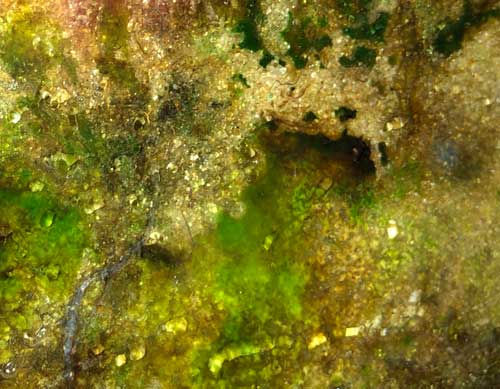
Deep sand bed in a saltwater aquarium
These are bacteria that live without oxygen. Deep in the sand bed (see where the name comes from?), these bacteria actually remove nitrate from the water column, effectively removing the waste from the tank. DSBs are not all roses…and in fact…they smell more like rotten eggs if you stir them up…but they can be a fun and functional option for your substrate.
If you are using anything other than Live Sand, please wash it thoroughly before you add it to your saltwater aquarium
Believe it or not… the sand is dirty. Unless you purchased some ultra-premium brand of mega-washed sand (how is that for a marketing claim…not too shabby), you will want to take the time to wash your sand before placing it in your aquarium. If you don’t (and maybe even if you do…) your tank is going to be very cloudy for the first several days while the small dust-sized particles in the sand (stirred up by the water) settle-out. If you can get some of those particles out in advance by washing the sand thoroughly, you will be a much happier saltwater aquarium owner.
Dry sand only or biologically active live sand too?
One more decision you have to make is whether you want to add any biologically active live sand to your aquarium. There are lots of different varieties of live sand, available in colors and sizes that will match your taste. The advantage of live sand is that it comes wet and biologically active, meaning it is already colonized by millions of bacteria. What this should mean to you is that you can either shorten the amount of time it takes for you to cycle your tank, or possibly even eliminate it altogether.
Bag of live sand
Dry sand, on the other hand, is biologically inactive, requires lots of washing before you add it to your tank, but it costs a lot less than live sand. The good news about bacteria and sand is that after some time in your saltwater aquarium, the bacteria will grow on what used to be your dry sand too, effectively converting it to the more expensive live sand.
So one thing to remember is that even if you want to give your biological filter a boost with live sand, you don’t have to fill the bottom of your tank exclusively with live sand. You can add a base of regular old dry sand and then add a bag or two of the live sand to top it off.
If you are starting with live sand, be sure to add enough newly mixed saltwater to your aquarium to keep the sand moist before moving on to the next step.
To dive deeper into the topic of picking the right aquarium substrate, check out this article here.
Step 5: Add and arrange your rock-work
Once you have poured your sand or crushed coral substrate into the aquarium, you can move on to the rock-work. Two of the most common types of rock mentioned in the saltwater aquarium hobby is dry rock and live rock.
Dry Rock
This is the kind of rock you would buy ‘off-the-shelf’ in your local fish store. Typically, dry rock is sold by the pound but is generally much less expensive than live rock. Because of the potential cost savings associated with dry rock, a lot of saltwater aquarium hobbyists buy the dry rock to use as the foundation of their rock-work.
The term, “dry rock,” refers to two elements–the first, and most obvious, is that this type of rock is generally sold dry…the second, the perhaps less obvious implication of the fact that it is sold dry is that this type of rock is not colonized with helpful bacteria or interesting invertebrates…it is just a dry chunk of the earth.
Live Rock
Live rock, by comparison, is a lightweight rock that has bacteria, algae, and invertebrates living on and in it. Live rock is also generally sold by-the-pound and is several times more expensive than dry rock.
As such, many people choose to use “Live Rock” more sparingly than dry rock, opting to use the live rock in the most visible areas to cover up the less desirable dry rock. Over time, you could achieve a degree of reef alchemy, because any rock (including dry rock) submerged in a saltwater aquarium would become live rock, once the rock is colonized with the bacteria, algae, and invertebrates associated with the term live rock.
For more information about live rock, including how much you need and how to cure it, check out the definitive guide to live rock, here.
Step 6: Mix up your saltwater
Now it is time to mix up your saltwater and place it in the tank. Ideally, it is best to mix your saltwater up at least a day before you plan to use it, but since this is the first time you are setting up your saltwater aquarium…I’ll give you a pass…because you probably don’t even own enough salt buckets yet to make that work. For now, just mix up a bucket, lug it over to your aquarium and fill ‘er up.
Don’t worry too much about what salt mix brand to purchase.
If you want to read my review of aquarium salt mixes, you can find that here.
How to mix the saltwater
If you have never mixed your own saltwater before and you want to know what is involved in the process, you can check out this short video on YouTube. Trust me, they even make this look more difficult than it truly is.
Yes, you should stir up the water until the water clears. Yes, you should heat it and leave it to settle overnight. All of that is best practice. All of that is what you should do on an ongoing basis. But to get started, you just measure out the right size scoop…drop in the bucket, fill with water up to the line…and stir.
A quick note of caution. If you ARE mixing up your water and placing it directly in your saltwater aquarium setup, there is a little risk that you will shock the living stuff on your live rock.
So if you have some expensive, killer live rock with awesome stuff growing on it (and you are worried about losing it), you may want to spend a little more time to let your water rest (and stabilize) over-night before adding it to your aquarium.
I’m making an assumption here, however, that the extra caution is unwarranted in most cases. Use your judgment when you set up your saltwater aquarium. If you have the time and self-restraint to wait a day, that would be the best approach.
Step 7: Place your powerheads
Having insufficient water flow is one of the top 5 most common saltwater aquarium mistakes. I wrote about it in an e-Book: Avoid the 5 MOST COMMON Saltwater Aquarium Mistakes. You can get a free copy by joining the newsletter community. (Want your own copy? Sign up here)
Here is the short version of why you need great water flow in your tank:
Flowing water is the life-blood of your tank. It takes oxygen and food to corals that can’t move and removes waste and carbon dioxide. A thriving, vibrant reef needs vigorous water flow. Now think about a stagnant pond–what image comes to mind? Are you picturing a pond scum infested body of water?
In some ways, that’s what can happen to your tank, if you don’t have enough water flow–problem algae get a foothold in those low-oxygen areas of the tank and can be the start of some big problems.
Back to the powerheads:
Powerheads are a great, inexpensive way to generate a lot of water flow in your tank. Learn more about some of the most efficient options here.
Step 8: Place your heater gently and out of site
If you own a saltwater aquarium with a sump, you probably want to place the heater in there, so it can run and heat the water completely out of view. If you don’t have a sump (that’s totally fine, you don’t need one), you could technically place your aquarium heater anywhere you want in the tank, as long as it is below the water level. It is best to give yourself at least an inch or two below the water level so that it remains submerged even if you have a fair amount of evaporation.
The heater is not the most attractive piece of equipment. Most people prefer not to see it. As such, the best location for the heater (if you don’t have a sump) would be to slide it down, in the back of the tank, preferably behind some live rock. Just be sure there is enough open space back there to ensure proper water circulation so that you can be sure you are efficiently heating your tank.
Step 9: Install your lights
Back in the day, people used to debate in online forums about what the best lighting source was for a reef tank. There were a lot more options back then–metal halide, VHO, HO, power compact. These lights are still available today, but at this time, it seems that LED aquarium lights rule the day. Long-lasting (they never quite seem to last as long as advertised, in my experience), energy-efficient, and cool-running, these lights tend to the right tool for the job, most of the time.
If you want to see how much it will cost (or how much you could save switching to LED), check out this article here.
To see a review of one of the most popular aquarium LED lights, check out this article here.
If you don’t want to shell out the dough for the big name brand, consider getting a discount brand online. I encourage you to read the reviews and pick a model that seems to have a good success rate from verified purchasers.
Congratulations. After your lights are set up, you have a saltwater aquarium.
If your lights don’t have a timer built into them, buy one online. Set the light period so that you have around 10-12 hours of light each day. You can scale that back a bit if you want to conserve energy, but 10-12 hours is about the right amount if you want to maximize coral growth.
If your light has different switches for the white vs. blue light, many people set the blue lights to come on for an hour or two before the white lights and for an hour or two after the white lights shut off.
You should seriously consider dimming your lights before adding your first few corals and gradually increasing the intensity once you’re sure they are adapting nicely to life in your tank. Failure to do so could result in stressed (dying) corals.
Step 10: Set up any remaining equipment
At this point, you have set up a functioning saltwater aquarium. You could get a lot of additional gear that can help you automate and improve the water quality, but everything else, from my perspective, is optional equipment.
Protein skimmers, refugia, wavemakers, chillers (in most locations), dosing pumps, UV sterilizers, reactors, and other equipment are helpful pieces of equipment that can help you build a better tank, but are not necessary.
Plug it in and turn it on
Depending on the size of your saltwater aquarium, your electric company should send out a rep to thank you, personally. Make sure you use a drip loop with your electrical wires. If you want to see how much electricity your tank takes to run, pick up this little contraption called a Kill A Watt. Plug your aquarium equipment into the same surge protector/power strip and then plug that into the Kill A Watt and find out how much electricity you really use.
Once you do that, you’ll start plugging everything into it just to see.
These are not expensive and will pay for themselves if you use them to find other energy-inefficient items around your house. I was amazed at how much electricity an old TV was sucking up. Yikes!!
Step 11: Cycle the tank before you add anything corals, fish, or other invertebrates
If you are new to the hobby, then this might sound a bit strange: the next thing you have to do before you add any fish or corals to your tank is cycling the aquarium.
The biggest challenge when keeping an aquarium is to keep the water parameters in the healthy range for the living things you want to keep in the tank. In the ocean, the currents take away waste and bring oxygen and food-rich water right up to the corals.
But your aquarium is a big glass or acrylic bucket. No waste gets removed unless you remove it (generally with water changes).
The biggest danger, when you first set up your tank, is a chemical called ammonia, which is a waste product created by rotting, leftover food and waste expelled by the fish, corals, clams, crabs, snails, shrimp, etc.
The good news is that naturally occurring bacteria will grow in your tank and convert that waste to a less toxic chemical (in 2 steps), called nitrate.
Nitrate will cause problems when it builds up, but it is not immediately toxic, like ammonia. These beneficial bacteria make up something called your biological filter. Establishing your biological filter is a process called cycling, which you can read more about here.
Adding a live rock, live sand, or a bacteria additive can help you speed up the cycling process.
Step 12: Set up a quarantine tank
Now, I know what you might be thinking…you just got 90% of the way through an article about setting up a new saltwater aquarium and I told you to set up a second aquarium before you even add your first fish.
Here is why–one of the biggest, preventable reasons people shut down their tanks forever is because they run into issues with saltwater ich, or another parasite, get a major infestation in their tanks and lose everything.
When that happens, it’s a frustrating, expensive, dark day, and it happens more than it should.
A quarantine tank is the best way to prevent pests and diseases from getting into your tank in the first place. A quarantine tank is a smaller, simple tank that is used to isolate, observe and treat (if necessary) any fish before you add them to your tank.
This gives you a safe location to identify and treat any issues before you add them to your tank.
Learn more about how to set up a quarantine tank here.
Step 13: Pick your first saltwater fish
Congratulations, you’re ready to pick your first saltwater fish. A first saltwater fish should be hardy (adapts well to the aquarium conditions in your home), inexpensive, and peaceful towards other tankmates.
Ideally, your first several fish will be aquacultured. That means they grew up on a fish farm, rather than in the ocean. In addition to being better for the natural reefs, aquacultured fish tend to better acclimate to life inside our homes.
For more information, check out the Saltwater Aquarium Fish Page.
Here are some other helpful articles to get you started:
Conclusion
Thanks for reading (or scanning) all the way to the bottom of this guide on how to set up a saltwater aquarium. I hope you found it helpful. If there is an intro topic that was not covered here, please leave a comment below and ask your question or leave your advice/recommendation, I welcome the help!
For more information
Watch this guide to setting up a super simple reef tank:
[ad_2]
Source link

